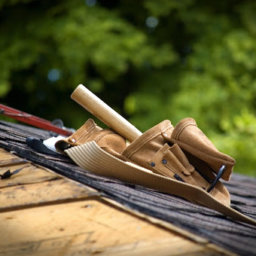When you live in an area that experiences frequent heavy rain or other natural disasters, it can be difficult to avoid some form of roof damage. Natural disasters like hurricanes, tornadoes and even hailstorms can significantly damage your home’s roof.
A leaky attic or a broken gutter may not seem like a big deal, but they can quickly become an issue to your roof if left unsolved.
If you have experienced damage to your roof due to weather conditions or other factors, you’ll need to take action immediately to protect your home’s roof from further damage. While it may not often happen, knowing how to deal with a damaged roof quickly and effectively is important.
Assess The Damage
Start by assessing the damage to your roof. What materials are damaged? Is there any buckling or curling in shingles? Are there any loose or torn shingles? It will help you figure out how best to proceed from there.
Assessing the damage can help you avoid wasting time and energy on repairs that aren’t necessary. You may need to get a roofing contractor to look at the damage and make a more precise assessment of what materials you’ll need to replace or repair.
Damage such as missing shingles, cracks in your roof system, and holes in your roof are all signs that your roof is compromised and needs to be addressed. If you notice any loose shingles, nail them back down to avoid them blowing away.
If the shingles are broken or cracked, you’ll need to remove them as soon as possible to prevent them from becoming a fall hazard. Damaged shingles should be replaced, as they can cause further damage to your roof if left in place.
Protect Your Home with A Tarp
If you find a leak or a tear in your roof, you’ll want to ensure that it doesn’t cause significant damage to your home’s interior. A Roofing tarp is a great way to protect the interior of your home while you find a roofing contractor and get the necessary repairs done.
Be sure to use a quality tarp that is designed to be weather-resistant. If you have a leaky roof, you may want to consider using a roof tarp as a temporary solution. Many tarps are made from plastic, rubber, and UV-resistant materials.
While a roof tarp can be a helpful tool for preventing roof leaks, it’s important to note that they are only a temporary solution. They are not designed to last for an extended period.
You should also be careful about using a tarp that is not designed for your specific roof type. Using the wrong type of tarp can cause more damage to your roof.
Check Your Home’s Foundation and Attic for Leaks
If your roof has sustained structural damage, there’s a good chance your home’s foundation and attic are also damaged. You can check for leaks in your attic by removing any insulation and checking for visible water damage.
Any damage to your roof will likely result in some water damage to your home. It can be minimized if you check for leaks in your attic and around your home’s foundation. Some common signs of roof damage include warped shingles or other roofing materials, curled shingles, or gaps between shingles.
If you notice water leaks around your home, you should contact a roofing contractor to help you quickly identify and repair the issue. You may also need to hire a contractor to repair or replace portions of your home’s foundation.
You can save your home’s roof by installing a roofing contractor-recommended bandage. Roofing contractors sometimes recommend roof bandages as a quick and effective solution. A roof bandage is a temporary patch placed over any leaks or damaged areas in your roof.
Get A Roofing Contractor’s Assessment and Recommendations
If your roofing materials have been damaged, you may not know what type of repairs are necessary. If possible, you should get a roofing contractor’s assessment of the damage to your roof. A roofing contractor can assess your home’s roof and provide you with an estimate for the necessary repairs.
A roofing contractor can also recommend ways to increase the lifespan of your roof, such as adding roofing sealant. They will also be able to give you an estimate of how much the repairs will cost. A roofing contractor can help you determine the best roofing materials for your roof.
Knowing what roofing materials to use for your home is not easy. There are many roofing materials, including asphalt, wood shakes, and metal.
Take Action by Repairing or Replacing Your Roof
You’ll likely need to repair or replace your roof if severely damaged. Act as soon as possible if you need to replace your roof, as it can be very expensive and time-consuming.
If you have homeowners’ insurance, you may be able to get the roofing repairs or replacement costs covered. Check your policy to see what types of roof damage are covered by insurance.
Hiring a contractor with a solid reputation and well-versed in using your specific roofing materials is essential. Employing a contractor who is not professional could end up causing more damage to your roof.
You can use new shingles or roofing tiles to re-cover the roof with a new material layer. It may be an option if the damage isn’t extensive or you want to save on repair costs.
A DIY roof replacement can be challenging and you will need to hire a contractor for any complicated repairs. Be sure to let your contractor know you are doing the replacement or repair yourself so they can provide you with helpful advice.
A properly maintained roof can help prevent water from seeping through and damaging the interior of your home. Roof damage is a common problem for most homeowners. When you notice damage to your home’s roof, it is critical to take corrective action immediately.
A roofing contractor can assist you in evaluating the damage and helping you decide whether to repair or replace the roof to protect your home from any additional damage.
Photo by Phil Hearing on Unsplash








